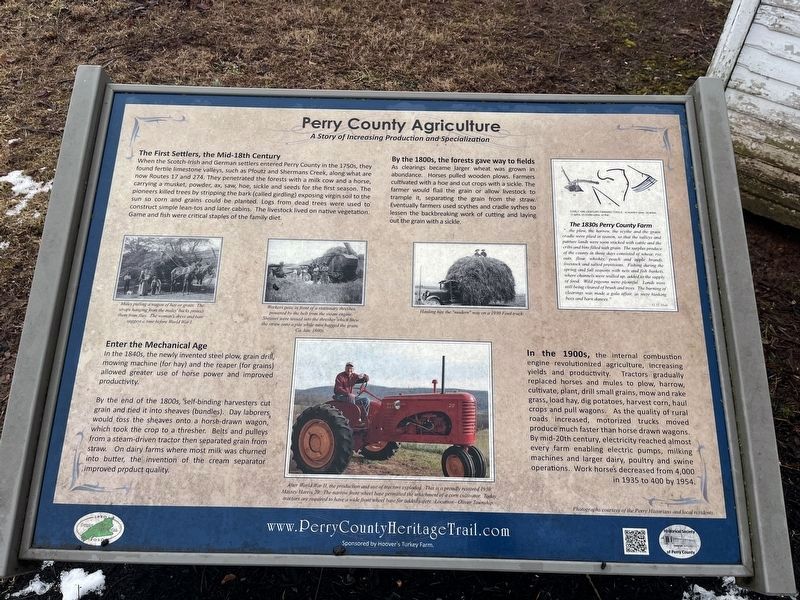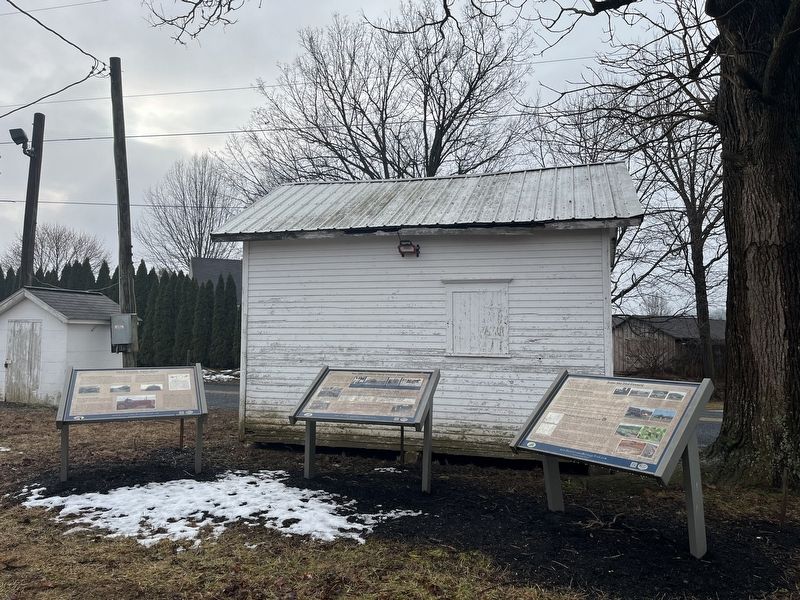Oliver Township near Newport in Perry County, Pennsylvania — The American Northeast (Mid-Atlantic)
Perry County Agriculture
A Story of Increasing Production and Specialization
— Perry County Bicentennial 1820-2020 —
The First Settlers, the Mid-18th Century
When the Scotch-Irish and German settles entered Perry County in the 1750s, they found fertile limestone valleys, such as Pfoutz and Shermans Creek, along what are now Route 17 and 274. They penetrated the forests with a milk cow and a horse, carrying a musket, powder, ax, saw, hoe, sickle and seeds for the first season The pioneers killed trees by stripping the bark (called girdling) exposing virgin soil to the sun so corn and grains could be planted. Logs from dead trees were used to construct simple lean-tos and later cabins. The livestock lived on native vegetation. Game and fish were critical staples of the family diet.
By the 1800s, the forests gave way to fields
As clearings became larger wheat was grown in abundance. Horses pulled wooden plows. Farmers cultivated with a hoe and cut crops with a sickle. The farmer would flail the grain or allow livestock to trample it, separating the grain or allow livestock to trample it, separating the grain from the straw. Eventually farmers used scythes and cradle scythes to lessen the backbreaking work of cutting and laying out the grain with a sickle.
Explore the Mechanical Age
In the 1840s, the newly invented steel plow, grain drill, mowing machine (for hay) and the reaper (for grains) allowed greater use of horse power and improved productivity.
By the end of the 1800s, self-binding harvesters cut grain and tied it into sheaves (bundles). Day laborers would toss the sheaves onto a horse-drawn wagon, which took the crop to a thresher. Belts and pulleys from a steam-driven tractor then separated grain from straw. On dairy farms where most milk was churned into butter, the invention of the cream separator improved product quality.
In the 1900s, the internal combustion engine revolutionized agriculture, increasing yields and productivity. Tractors gradually replaced horses and mules to plow, harrow, cultivate, plant, drill small grains, mow and rake grass, load hay, dig potatoes, harvest corn, haul crops and pull wagons. As the quality of rural roads increased, motorized trucks moved produce much faster than horses drawn wagons. By mid-20th century, electricity reached almost every farm enabling electric pumps, milking machines and larger dairy, poultry and swine operations. Work horses decreased form 4,000 in 1935 to 400 by 1954.
[Sidebar:]
"…the plow, the harrow, the scythe and the grain cradle were plied in season, so that the valleys and pasture lands were soon stocked with cattle and the cribs and bins filled with grain. The surplus produce of thecounty in those days consisted of wheat, rye, oats, flour, whiskey, peach and apple brandy, livestock and salted provisions. Fishing during the spring and fall seasons with nets and fish baskets, where channels were walled up, added to the supply of food. Wild pigeons were plentiful. Lands were still being cleared of brush and trees. The burning of clearings was made a gala affair, as were husking bees and barn dances."Photographed By Devry Becker Jones (CC0), February 23, 20242. Set of markers at Perry County Fairgrounds
H.H. Hain
[Captions:]
Mules pulling a wagon of hay or grain. The straps hanging from the mules' backs protect them from flies. The woman's dress and hair suggest a time before World War I.
Workers pose in front of a stationary thresher, powered by the belt from the steam engine. Sheaves were tossed into the thresher which blew the straw onto a pile while men bagged the grain. Ca. late 1800s.
Hauling hay the "modern" way on a 1930 Ford truck.
After World War II, the production and use of tractors exploded. This is a proudly restored 1950 Massey Harris 20. The narrow front wheel base permitted the attachment of a corn cultivator. Today tractors are required to have a wide front wheel base for added safety. Location - Oliver Township.
Erected by Historical Society of Perry County.
Topics and series. This historical marker is listed in these topic lists: Agriculture • Colonial Era • Settlements & Settlers. In addition, it is included in the Perry County Heritage Trail in Pennsylvania. series list. A significant historical year for this entry is 1935.
Location. 40° 29.487′ N, 77° 8.586′ W. Marker is near Newport, Pennsylvania, in Perry County. It is in Oliver Township. Marker is on Fairground Road west of Sheck Drive, on the right when traveling west. The marker stands on Perry County Fairgrounds. Touch for map. Marker is at or near this postal address: 885 Sheck Dr, Newport PA 17074, United States of America. Touch for directions.
Other nearby markers. At least 8 other markers are within walking distance of this marker. The 20th Century Perry County Farm (here, next to this marker); Enter the 21st Century (here, next to this marker); Agricultural Fairs in Perry County (within shouting distance of this marker); The Newport Public Library (approx. 0.8 miles away); Billy Cox (approx. 0.9 miles away); Newport and World War I (approx. 0.9 miles away); The Bechtel Tannery (approx. 0.9 miles away); Veterans Memorial Park (approx. 0.9 miles away). Touch for a list and map of all markers in Newport.
Credits. This page was last revised on February 25, 2024. It was originally submitted on February 25, 2024, by Devry Becker Jones of Washington, District of Columbia. This page has been viewed 46 times since then. Photos: 1, 2. submitted on February 25, 2024, by Devry Becker Jones of Washington, District of Columbia.

